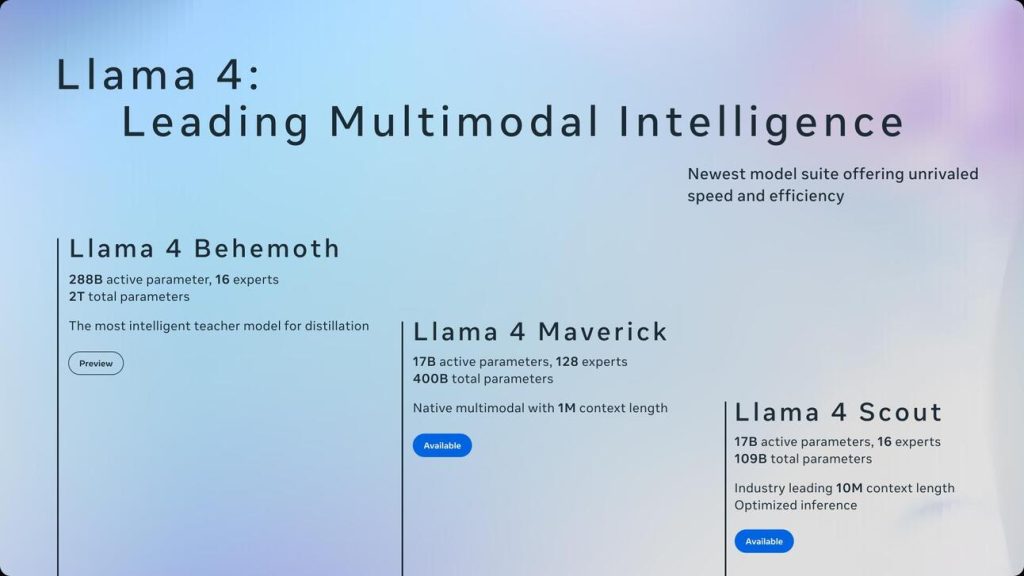Embracing the Future with Llama 4

The AI landscape is evolving with the release of Llama 4. This new model family promises unmatched speed and efficiency. Whether you’re a researcher or developer, these models are made for you.
With Meta’s new Llama 4 models, innovation meets practicality. This AI race takes a significant turn, enhancing various applications. Its impact is bound to be far-reaching. Excitement is palpable and expectations are high.
The Unveiling of Llama 4: A New Era Begins
Meta has launched three versions of Llama 4, each designed for incredible performance. These models promise enhanced speed and operational efficiency. They’re open to researchers, making significant contributions to the field inevitable. The introduction of these models marks a pivotal moment in AI advancement.
Versatility of Llama 4 Models
The innovation in Llama 4 models reflects in their versatile use across platforms like WhatsApp and Messenger. Developers have the chance to integrate these models easily, opening doors to potential new applications. The adaptability of these versions is a standout feature.
Scout, Maverick, and Behemoth are more than just names. Each version caters to different needs, from handling longer documents to multilingual capabilities. This diversity in functionality sets a new standard in AI technology.
Scout: Efficiency at Its Best
Scout operates on a single Nvidia chip, highlighting its efficiency.
Its ability to outperform rivals like Google’s Gemma 3 presents a significant leap. The model’s 10M-token context window allows for handling extensive tasks, making it an industry leader.
Scout not only meets industrial benchmarks but exceeds expectations. This model is designed for seamless multitasking, proving its superiority in complex environments.
Maverick: Handling Text and Images
Maverick is perfect for applications involving text and images.
Its ability to analyze photo uploads while supporting 12 languages widens its appeal.
Maverick’s design is meant to bridge the gap between text-based and image-based AI. It offers solutions that are both comprehensive and efficient, making it invaluable to developers seeking dynamic applications.
Behemoth: The Powerhouse Model
Behemoth stands out as the most powerful version.
It hasn’t been released to the public yet but outperforms notable models like GPT-4.5 and Claude 3.7.
Behemoth’s capabilities are vast. Its potential for STEM applications showcases its strength, positioning it as a front-runner in AI development.
The Road Ahead for GPT-5
GPT-5’s anticipated release faces delays. The wait brings an unexpected advantage—it promises a model much stronger than expected.
OpenAI’s decision to separate models and launch them individually adds a strategic element to their rollout.
The future of GPT-5 is bright despite the delays. Its eventual release is expected to bring about advancements that will set new industry benchmarks.
Tech Giants Race for AI Supremacy
With Google’s Gemini 2.5 Pro entering the scene, tech giants are in fierce competition.
These advancements reflect the dynamic nature of AI development. innovations are continually reshaping the technological landscape.
Beyond the Models: Practical Applications
AI’s role extends into daily tasks with tools like Spinach AI offering to streamline operations.
AI agents simplify competitive analysis, allowing businesses to focus more on strategy than manual tasks.
AI Tools Enhancing Productivity
New AI tools are emerging to boost productivity and efficiency in various sectors.
From scheduling meetings to building websites, AI is revolutionizing the way professionals manage their workload.
Llama 4 ushers in a new chapter in AI technology. Its diverse capabilities pave the way for future innovations. Whether in research or everyday applications, its impact will be profound.





